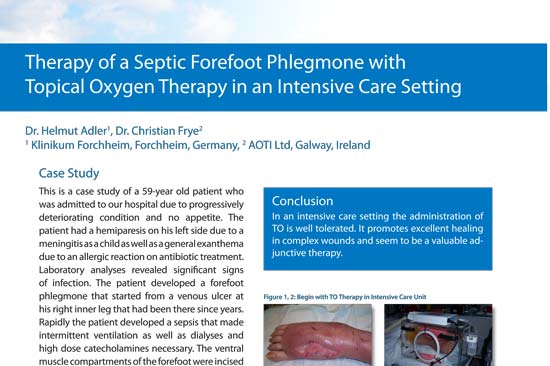Therapy of a Septic Forefoot Phlegmone with Topical Wound Oxygen (TWO2) in an Intensive Care Setting
Dr. Helmut Adler1, Dr. Christian Frye2
1 Klinikum Forchheim, Forchheim, Germany, 2 AOTI Ltd, Galway, Ireland
Case Study
This is a case study of a 59-year old patient who was admitted to our hospital due to progressively deteriorating condition and no appetite. The patient had a hemiparesis on his left side due to a meningitis as a child as well as a general exanthema due to an allergic reaction on antibiotic treatment. Laboratory analyses revealed significant signs of infection. The patient developed a forefoot phlegmone that started from a venous ulcer at his right inner leg that had been there since years. Rapidly the patient developed a sepsis that made intermittent ventilation as well as dialyses and high dose catecholamines necessary. The ventral muscle compartments of the forefoot were incised followed by an open wound therapy for 4 weeks. As laboratory infections signs started to increase again, the wound was revised followed by 4 weeks of Negative Pressure Treatment (NPT). The lower leghadasignificantedemaatthispoint.Thewound has granulated well but showed a great deal of sludge. Wound healing had stalled with no further signs of epitheliasation. Therefore we started Topical Oxygen* (TO) therapy at a duration of 3-6 hours per day 8 Week after the first surgery. Even though massive substitution of liquids was still necessary the edema of the lower leg and the foot was reduced remarkably. The wound epithelialised quickly. The venous ulcer at the lower leg that was responsible for the sepsis healed within 30 days during intensive care. The incision on the foot showed good granulation. In total the patient spent 14 weeks in intensive care! The patient was dismissed from intensive care in a center of neurologic rehabilitation.
Conclusion
In an intensive care setting the administration of TO is well tolerated. It promotes excellent healing in complex wounds and seem to be a valuable ad- junctive therapy.
